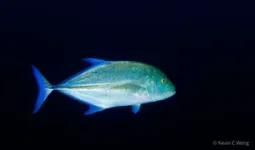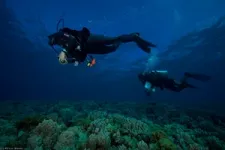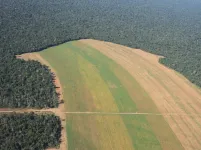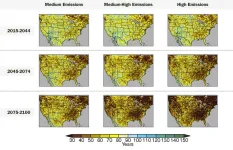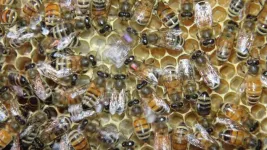(Press-News.org)
During August 2019, more than 40,000 tourists visited Hawaii’s Molokini island to snorkel or dive. In March 2020 the worldwide COVID lockdown dropped that number to zero.
The sudden and prolonged drop in visitors to one of the world’s most popular snorkeling spots provided scientists with a novel opportunity to study how underwater tourism impacts marine fishes. The results of their study, published in the most recent issue of PLOS One, will help resource managers better care for Molokini and other threatened marine habitats.
The study’s lead author, Dr. Kevin Weng of William & Mary’s Virginia Institute of Marine Science, says “The COVID-related tourism freeze provided a unique natural experiment to measure the effects of decreased tourism on fish behavior in a high-use, no-take marine protected area.” Joining Weng on the study were Dr. Alan Friedlander and Whitney Goodell of the National Geographic Society and Dr. Laura Gajdzik and Russell Sparks of the Hawaii Department of Land and Natural Resources. Friedlander and Goodell are also affiliated with the University of Hawaii at Mānoa.
Molokini, which lies about 3 miles off the shore of Maui, was designated as a “no-take” marine protected area or MPA in 1977 based on tour operators' concerns regarding the impacts of fishing and other “consumptive” uses. “Tour operators have always been interested in the conservation of Molokini, and have worked with the State on several measures," says Sparks. As the volume of “non-consumptive” uses such as snorkeling and SCUBA diving increased, tour operators worked with the State to establish a limited-entry permit system for tour boats and to replace anchoring with permanent moorings to protect corals.
The current study focused on the impacts of these non-consumptive uses. “Our research demonstrates that human presence alone can alter the community structure and possibly the functioning of an ecosystem,” says Weng. “This means we can improve how tourism is configured in Hawaii and around the world to reduce the impacts of human presence.”
Community structure refers to the type and numbers of species present in an ecosystem. During Hawaii’s COVID lockdown—which began at full force in March of 2020 and was then slowly lifted until visitation returned to pre-pandemic levels in May of 2021—the researchers conducted SCUBA surveys on five separate occasions to record the species, abundance, size, and location of predatory and herbivorous fishes within Molokini’s submerged crater. They also tracked the movement of the predatory species using electronic tags. Comparing these observations with data from similar surveys conducted in the years before and after the lockdown allowed them to detect differences in fish community structure caused by human presence. The researchers gathered data on human presence using logbooks kept by the 40 charter boat companies permitted to bring tourists into Molokini’s waters.
The results of this natural experiment were clear. “When tourism shut down due to COVID,” says Friedlander, “species that had been displaced from shallow habitats by high human presence moved back in on a timescale of months, increasing fish biomass as well as the proportion of larger predators." The species that mainly drove the observed increase in lockdown biomass were fast-swimming predatory fishes known as jacks, which learn to fear humans as they are often targeted by anglers. When tourism resumed, the predators moved to deeper waters, reducing fish biomass and habitat use to pre-pandemic levels. Biomass is a combined measure of fish abundance and size.
The observed changes in predator biomass were also reflected in the fishes’ behavior. Before the COVID lockdown, jacks were known to leave the inside of the crater during the morning peak in tourist visits. However, during the lockdown, they remained in the shallow, sheltered interior. These predators were quickly displaced from this shallow-water habitat whentourism resumed. Their displacement is particularly concerning because their summertime spawning season overlaps with the annual peak in marine tourism.
The human-induced displacement of predatory fishes from Molokini’s crater likely sends ripples throughout the local food web. Previous studies have shown that a drop in the abundance of predatory fishes affects not only the herbivorous fishes they count as prey, but the algae and other primary producers eaten by the herbivores. “Predators have diverse ecosystem roles,” says Friedlander, “and their loss can reduce the resistance and resilience of ecosystems to other stressors.”
Overall, the team’s findings suggest that "Molokini is being over-used, and that management is needed to improve not only ecosystem health but the visitor experience," says Sparks. “Our findings indicate that the business-as-usual conditions of high tourism alter community structure by displacing predatory fishes to deeper environments,” adds Weng. Moreover, a 2011 study found that more than two thirds of visitors to Molokini felt crowded during their trip and supported actions that would reduce visitor numbers.
“As Hawaii formulates marine management plans and undertakes the Sustainable Hawai`i Initiative,” says Gajdzik, “lessons from Molokini can help inform managers and help facilitate an effective response. As part of this process, we need to think strategically about the scale and configuration of tourism in Hawaii to optimize earnings and employment without damaging the environment.”
“Our study indicates that the intensity of non-consumptive uses, especially in heavily visited MPAs, should be considered for the long-term health and resilience of these ecosystems,” says Weng. “Management of tourism should be guided by biological research, and include clear and well-enforced rules, adaptive management, and broad stakeholder involvement.”
END
Researchers from Children’s Hospital of Philadelphia (CHOP), Florida State University (FSU), and the University of California, Los Angeles (UCLA) have demonstrated that starting intervention coaching parents of autistic toddlers as early as 18 months leads to better gains in language, social communication, and daily living skills.
Their findings were recently published in the journal Autism.
While prior studies provided strong evidence for the benefits of early intervention in autism, many are correlation studies rather than randomized controlled studies that ...
As Brazil seeks ways to protect its crucial Amazon Forest, a new study shows that excusing private landowners from conserving their precious land has come at a steep cost to global sustainability.
In this week’s Nature Communications Earth & Environment, scientists at Michigan State University’s Center for Systems Integration and Sustainability (MSU-CSIS) as well as Brazil and the UK found that since 2012 more than half of the deforestation in the Brazilian Amazon has taken place on designated private conservation areas within rural private properties. However, ...
CLEVELAND–By discovering how zebrafish use their hair cells to detect distant movement, a team of Case Western Reserve scientists may have found a path to help explain human hearing loss.
Even though the tiny water creatures and humans would appear to have nothing in common, the structure and function of the hair cells on zebrafish skin are nearly identical to cochlear hair cells found in the human inner ear.
In addition, both the fish and human cell receptors have a type of protein known as an “ion channel,” which converts the waves that the cells detect into electrical impulses that carry useful information.
However, in humans, ...
Wildfires. Many see them as purely destructive forces, disasters that blaze through a landscape, charring everything in their paths. But a study published in the journal Ecology Letters reminds us that wildfires are also generative forces, spurring biodiversity in their wakes.
“There’s a fair amount of biodiversity research on fire and plants,” said Max Moritz, a wildfire specialist with UC CooperativeExtension who is based at UC Santa Barbara’s Bren School of Environmental Science & Management, and is the study’s lead author. Research has shown that in ecosystems where fire is a natural and regular occurrence, there ...
A key source of information underpinning the upcoming National Climate Assessment suggests that heavy precipitation days historically experienced once in a century by Americans could in the future be experienced on several occasions in a lifetime.
Scientists at Scripps Institution of Oceanography at UC San Diego and the Department of Energy’s Lawrence Berkeley National Laboratory (Berkeley Lab) report that extremely intense days of rain or snow will be more frequent by the end of this century than previously thought ...
A spin-out company from the graphene innovation ecosystem at The University of Manchester has formed an international partnership that will spearhead an unprecedented scale-up of graphene-based technologies intended “to make a substantial impact on global CO2 emissions”.
UK-based Graphene Innovations Manchester Ltd (GIM), founded by University of Mancheser graduate Dr Vivek Koncherry, has signed a Memorandum of Understanding (MoU) with Quazar Investment Company to create a new company in the UAE. Graphene innovation has "
This agreement - ...
“ChatGPT is a very impressive tool,” said paper author Zijian Hong, professor at the School of Materials Science and Engineering, Zhejiang University, China. “As a computational materials scientist, I’m always eager to embrace new tools, in particular, new tools in computer science and AI. Since the born of the new ChatGPT, I’m just wondering whether such a tool can assist us in computational materials science”
Hong explained that for a computational materials task, there are three main steps: building a model or a structure, writing ...
Three-dimensional simulations shed light on how energy dissipates within non-Newtonian fluids (fluids in which viscosity depend on the shear rate.) The result is valuable in the context of disaster forecast and management or industrial production.
Elastoviscoplastic (EVP) fluids like mud, concrete, and lava are a type of non-Newtonian fluid that exhibit both solid and fluid-like behavior depending on the forces they are subjected to (i.e., applied stress). Their flow behavior is more complex than that of Newtonian fluids, such as water and air, which have a constant viscosity. In a recent study, researchers ...
Researchers from the Xishuangbanna Tropical Botanical Garden (XTBG) of the Chinese Academy of Sciences and the University of California San Diego have revealed that receiving an inhibitory signal (stop signal) associated with negative food conditions can decrease brain dopamine levels in dancing honeybees.
The study was published in Current Biology on April 13.
Dopamine is known as the feel-good neurotransmitter—a chemical that ferries information between neurons. In multiple animals, dopamine is involved in arousal, cognition, and sensitivity to stimuli. It is also associated with seeking and wanting behavior, particularly ...
About The Study: In this analysis of more than 5 million hospitalizations between 2020 and 2022, health care–associated infection (HAI) occurrence among inpatients without COVID-19 was similar to that during 2019 despite additional pressures for infection control and health care professionals. The findings suggest that patients with COVID-19 may be more susceptible to HAIs and may require additional prevention measures.
Authors: Kenneth E. Sands, M.D., M.P.H., of HCA Healthcare in Nashville, is the corresponding author.
To access the embargoed study: Visit our For The Media website at this link https://media.jamanetwork.com/
(doi:10.1001/jamanetworkopen.2023.8059)
Editor’s ...

